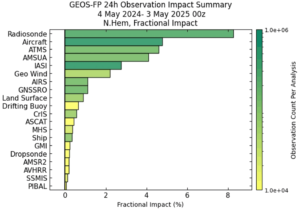Hurricane season starts today, and above-average activity is predicted. But America’s premier agencies for protecting lives and property from these destructive storms – the National Atmospheric and Oceanic Administration, or NOAA, and the Federal Emergency Management Association, or FEMA – are in unprecedented disarray. The chaos will likely harm hurricane forecast accuracy in 2025, as well as disaster preparation and response.
NOAA reeling from huge staffing losses
Massive staffing losses at NOAA from firings of probationary employees, DOGE buyouts and early retirements have left at least eight of the 122 National Weather Service offices unable to operate around the clock.

Because of the loss of staff, regular twice-per-day upper air balloon soundings – which are typically the most important ingredient in making reliable model weather forecasts – have been lost from 18% of the nation’s upper air stations. Some locations have been reduced to once-per-day launches, and a number are doing no launches at all. The Washington Post reports that since March 20, 17% of all U.S. balloon launches that should have occurred have not, mostly because of NOAA staffing losses.
The greatest data loss is in the Midwest U.S., which will cause significantly degraded forecasts of hurricanes making landfall along the U.S. Gulf and Atlantic coasts in some situations. It is difficult to quantify the exact degradation, since the researchers needed to perform the “data denial” studies that could inform us have been laid off or are stretched too thin to do the research needed.
While we can expect that the National Hurricane Center will order special balloon launches in the case of a landfalling hurricane, it is questionable whether local National Weather Service offices will have the staff to comply. (And note that balloon launches are often canceled for unanticipated reasons, such as maintenance issues, thunderstorms nearby making it unsafe to do the launches, etc.) Because of the loss of balloon data in 2025, the size of the NHC cone will likely be too small in some situations, giving people overconfidence in the accuracy of hurricane forecasts. Such overconfidence can result in delayed evacuation decisions and failure to take adequate measures to protect lives and property.
Moreover, the loss of National Weather Service staff will likely affect local hurricane forecasts and warnings issued by some NWS offices serving hurricane-prone coasts. The situation is particularly acute in Houston, where the office’s website lists 11 vacancies out of a staff of 25 – a 44% understaffing.
As Alan Gerard wrote in April in his excellent Balanced Weather Substack feed, “The NWS office in Houston – one of the largest metropolitan areas in the country with tremendous vulnerability to hazardous weather – will soon be without any permanent management staff: Their meteorologist-in-charge, warning coordination meteorologist, science and operations officer, and electronics system analyst will all be retired by the end of April. While I have no doubt that remaining NWS leadership will do what they can to mitigate the impacts of this situation, there is clearly nothing ‘strategic’ about leaving this NWS office in particular without any permanent managerial staff as we approach hurricane season.”
A number of NWS offices that serve coastal areas impacted by hurricanes have staff listings that show their current number of vacancies. As of May 28, 2025, here is the level of understaffing that was listed at each office. (Actual staffing shortages may differ from the numbers listed on the websites, particularly at offices so understaffed that they don’t have time to update their webpages.)
Houston, Texas: 44% understaffed (11 of 25 positions vacant)
Miami, Florida: 25% understaffed (six of 24 positions)
Key West, Florida: 19% understaffed (four of 21 positions)
Tampa Bay, Florida: 29% understaffed (seven of 24 positions, including their meteorologist-in-charge)
Jacksonville, Florida: 9% understaffed (two of 23 positions, which happen to be two of the top three leadership positions)
Charleston, South Carolina: 22% understaffed (five of 22 positions)
Wilmington, North Carolina: 21% understaffed (five of 24 positions)
Newport, North Carolina: 14% understaffed (three of 22 positions)
Wakefield, Virginia: 0% understaffed (Zero of 22 positions)
Boston, Massachusetts: 19% understaffed (five of 26 positions)
New Orleans, Louisiana: no general staff info given, but one leadership position was unfilled: Science & Operations Officer
Lake Charles, Louisiana: 15% understaffed (three of 20 positions, reported by Washington Post)
Corpus Christi, Texas: 11% understaffed (two of 19 positions)
Brownsville, Texas: 9% understaffed (two of 23 positions)
San Juan, Puerto Rico: 21% understaffed (five of 24 positions)
Honolulu, Hawaii: 10% understaffed (three of 29 positions)
Staff at regional NWS offices are also suffering a serious loss of leadership. Three of seven of the top positions are unfilled for the Southern Region, as well as three of six top positions for the Western Region. Fortunately, the National Hurricane Center is faring better than many NWS offices: a staff listing shows just 4% understaffing (3 vacancies out of 73 positions) – fewer vacancies than were listed in September 2024.
A recent effort by NWS seeks to fill 155 “critical” vacancies at particularly understaffed offices through transfers from other offices. This would be an exercise in “robbing Peter to pay Paul” since the total number of vacancies in the NWS would remain the same.
FEMA unprepared for hurricane season
When Hurricanes Helene and Milton – both made more destructive by climate change – devastated the Southeast last fall, workers at the Federal Emergency Management Agency, or FEMA, oversaw the government’s effort to rescue survivors and aid the recovery. FEMA has been key, too, in bolstering the country’s long-term resilience efforts, such as elevating flood-prone homes and installing drainage works.

But according to a May 15 report from CNN, an internal agency review prepared at the direction of new acting FEMA Administrator David Richardson said, “As FEMA transforms to a smaller footprint, the intent for this hurricane season is not well understood. Thus FEMA is not ready.”
According to the CNN story, FEMA “has lost roughly 30% of its full-time staff to layoffs and DOGE buyouts, including some of its most experienced and knowledgeable senior leadership.” Furthermore, Trump officials are discussing sharply raising the threshold for states to qualify for federal disaster assistance, and both Trump and Homeland Security Secretary Kristi Noem have advocated drastically shrinking FEMA or eliminating it.
On May 21, CBS reported that acting FEMA administrator David Richardson – who has no emergency management experience – rescinded the agency’s strategic plan, a policy document that forms FEMA’s “organizational backbone.”
Targeted for elimination was FEMA’s Office of Resilience Strategy, which “exists to figure out how to maximize efficacy of publicly spent money on projects that build a resilient infrastructure that can withstand disaster events,” the report quoted one FEMA official as saying. “Without that guiding star, FEMA will operate as triage instead of actually trying to mitigate future damage before it happens.” The official compared its removal to “people relying solely on emergency rooms for health care rather than also getting preventative care.”
The chaos at FEMA could result in slower disaster responses, longer waits for payouts, and reduced implementation of resilience efforts, ultimately increasing damage from climate change-enhanced extreme weather. As of April 1, there was already an “unusual” backlog of requests for disaster declarations, the Washington Post reported. In addition, firings could hamper efforts to update the agency’s significantly outdated flood maps, which are critical for determining flood risk and insurance rates.
Compounding the diminishment of FEMA’s capability for the upcoming hurricane season are the massive cuts to AmeriCorps, which has in the past provided key disaster recovery services. According to reporting from Grist, in April, “AmeriCorps placed 85 percent of its 500 staff on leave and canceled nearly $400 million in grants out of a $1 billion budget. The move effectively ended the service of an estimated 32,000 AmeriCorps workers across the country.”
Bottom line: With climate change already making the strongest hurricanes stronger, and with the U.S. now in the midst of a historic period of landfalls from high-end Cat 4 and Cat 5 hurricanes, critical deficiencies at NOAA and FEMA for the upcoming hurricane season represent a serious risk to lives and property.
Bob Henson contributed to this post. This article first appeared on Yale Climate Connections and is republished here under a Creative Commons Attribution-NonCommercial-NoDerivatives 4.0 International License.
Sign up for The Invading Sea newsletter by visiting here. To support The Invading Sea, click here to make a donation. If you are interested in submitting an opinion piece to The Invading Sea, email Editor Nathan Crabbe at nc*****@*au.edu.



